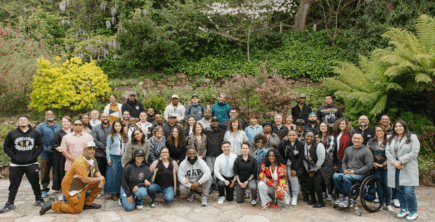
LGBT
There’s no doubt that we’re witnessing a surge of generosity in the United States. Charitable giving was up more than five percent last year, with total donations crossing the $400 billion mark for the first time.1 As Americans get, we give, and nowhere is that more clear than here in the Bay Area, adjacent to Silicon Valley. Sixty percent of the total contributions from The Chronicle of Philanthropy’s annual ranking of the top 50 donors—a collective $8.7 billion—were from individuals or families whose wealth came from technology.2 It’s possible that organizations could be benefiting from this new source of funding: according to statistics from Nonprofit Research Collaborative, 63 percent of organizations reported an increase of funds last year, compared to the year before. But the question is, where is the money going, and more importantly, who is being left behind?
There is danger in focusing on the where, instead of the who and the what. By doing so, we are missing opportunities to drive the impactful work of the people on the ground, closest to the issues—those most likely to know what is working, and what is not.
Two years ago, a report called The Giving Code grappled with this very question, using Silicon Valley’s rising inequality as a backdrop. It found that 93 percent of all giving by Silicon Valley foundations was directed to non-profits outside the area. Only 3 percent of the remaining funds that did stay in the area went to local, community-based organizations.3 These figures prompted many to take a long, hard, and necessary look in the mirror. Since the report’s release, I have been in multiple convenings, meetings, and conversations when it comes up, and all too often, the response sounds like this: “We are thinking about reducing our global giving to give more locally.” Or, like this: “We have a national program on health inequities, but we are thinking about moving more funding locally.”
I think it’s wonderful that The Giving Code has had such lasting impact. Philanthropists should do more to learn about local issues and solutions—and nonprofits should do more to facilitate crucial connections between those who have the most and those who need the most. But both the report’s thoughtful final recommendations and these reactions to them fail to acknowledge that when money is invested locally, it’s often going to already wealthy institutions.
There is danger in focusing on the where, instead of the who and the what. By doing so, we are missing opportunities to drive the impactful work of the people on the ground, closest to the issues—those most likely to know what is working, and what is not.
The trend that The Giving Code addresses impacts far more than just Silicon Valley. Rising inequality is a global issue and essential charitable dollars are falling short of community-based direct-service organizations in Seattle, New York, and many other major metropolitan areas across the country. Research now directly connects a rise in innovation to the rise of income segregation in a given city—making Silicon Valley a useful microcosm. Here, one in four residents is food insecure, according to research from Second Harvest. The housing crisis is very real. Across the state, 42 percent of households are cost-burdened, meaning that they pay 30 percent or more of their income on housing. As is the case nationwide, the discrepancies between have and have not cuts across issues, too.
One of these issues is education—one of the largest recipients of Americans’ generosity, after religion. Earlier this year, Stanford University announced the first cohort of 51 students who were accepted into the new Knight Hennessy Scholars program. With founding gifts totaling more than $750 million, the initiative is, according to its the website, the largest fully endowed graduate fellowship in the world. Compare that to the California Community Colleges (CCC), the largest system of higher education in the nation. The CCC serves 2.1 million students at 115 colleges. Its total endowment—for student scholarships, nursing education, and real estate education—is $94.7 million, according to the foundation’s website. An interesting way to look at this discrepancy is to calculate funds available compared to the number of students served. Just for fun, if both of these endowments had to be spent in a year (yes, I know that is not the purpose of the endowment) it would translate into $14,700,000 per fellow at Stanford and $45 per student at California City Colleges. The difference is staggering.
There is no question that we all benefit from cutting-edge research coming out of our leading institutions when those benefits are then infused, shared, or distributed for the public benefit, and not private markets. Some students who have access to these elite schools go on to address deep social problems in powerful ways. However, when it comes to educational charitable dollars that support low-income students and social mobility, the numbers just don’t add up.
There is no question that we all benefit from cutting-edge research coming out of our leading institutions…However, when it comes to educational charitable dollars that support low-income students and social mobility, the numbers just don’t add up.
Contributions to colleges and universities in the United States were at an all-time high of $43.60 billion in 2017, according to the Council for Aid to Education. More than a quarter of that money went to 20 institutions—Stanford (raising $1.13 billion) was second only to Harvard University and many of the other big brand-names that typically follow in such a list. Compared to 2016, gifts to these 20 schools grew more than 10 percent, led by contributions from foundations and alumni. In addition to huge inequality in funding, students at elite colleges are even richer than experts realized, according to a new study from Opportunity Insights. Roughly one in four of the richest students attend an elite college—universities that typically cluster toward the top of annual rankings. In contrast, less than one-half of 1 percent of children from the bottom fifth of American families attend an elite college. In fact, less than half attend any college at all.4 We also know that it is the often underfunded, stretched community and state colleges that give immigrants, underserved, and poor students at least a chance of moving up the economic ladder. Elite institutions are arguably getting more than their fair share of the pie.
What if even a portion of those funds were directed differently? What if there were more people like the late Hank Rowan, a Massachusetts Institute of Technology–educated engineer and industrialist who chose to donate $100 million to Glassboro State College, a small engineering school of about 500 students in Southern New Jersey, instead of his alma mater? (The school was soon after re-named Rowan University.) Malcolm Gladwell’s Revisionist History podcast ran an excerpt of an interview5 with Rowan’s daughter, who remembers her father’s rationale: “He said, ‘I’m sure they would do good things with my money; they’d build a building or do something positive, but, he said, ‘it wouldn’t make the difference that’s it’s gonna make down here.’”6
Just as is true for elite universities, elite hospitals—some of which are affiliated with the very same universities—drive innovation and best-in-class research that will impact countless lives across the economic spectrum. But here, too, we see growing disparities. The Giving Code reported that hospitals—which make up a total of just 0.3 percent of the number of nonprofit organizations in Silicon Valley—command the second highest share of public charity revenue, behind higher education. The wealthiest have both billions of dollars in revenue and significant donor support, while their public counterparts in high-need areas struggle to keep up with growing demand. A spokesperson for California Hospitals Association recently called the financial situation for small, independent hospitals in the area “precarious at best.”
One crucial source of care is the community health center, which Kaiser Family Health calls “the nation’s largest source of comprehensive primary care for medically underserved communities and populations.” Center for Care Innovations, a Tides social venture, supports a network of more than 1,750 clinics, helping each of them bring the best tools and resources to those who need it most. By providing education, strategic guidance, and collaboration opportunities to practitioners, CCI’s impact is amplified outside the bounds of a single organization; it expands along with the reach of the community health centers themselves.
As thrilling as it is to see the contributions that we as a collective and so many of us individually are making to philanthropy, we need to look beyond the big numbers. At the ecosystem level, the trickle-down philanthropy is not working.
We need to be aware of the nuances here. We are not going to—nor should we—stop giving to our alma maters and other causes that need our support. This is not about pitting subsistence farmers in African countries against the food insecure in San Mateo, or about abandoning Stanford and giving everything to the next local charity that you spot at the grocery store.
A portfolio approach to philanthropy would challenge us to think and invest differently. This approach could include dual-level approaches such as: global and local; large scale and small scale; immediate needs and root causes; elite institutions and on-the ground organizations.
What this is about is taking a moment to consider how the way we give is helping to solve the problems of our time. When it comes to our personal finances, we would not consider putting all our eggs in one basket. We should take a similar “portfolio” approach to giving. By engaging more deeply with the who and the what, we can broaden our understanding of solutions that will best serve the people who are most in need. What if, for every $10 million that goes to Stanford, a wealthy donor considered shifting $1 million (or maybe even $10 million!) to the community college or high school in a neighborhood that would be transformed? What if you invested in food security in poor countries as well as your own community? Ultimately, we all want to support solving the challenges of our time. A portfolio approach to philanthropy would challenge us to think and invest differently. This approach could include dual-level approaches such as: global and local; large scale and small scale; immediate needs and root causes; elite institutions and on-the ground organizations. This is not an exhaustive framework but hopefully a good place to start the conversation.
This same portfolio approach can also apply to the way that we spend our time. According to The Giving Code, networks of well-meaning donors often do not intersect with those of nonprofit leaders working locally. We know that change only comes through the effort of crossing sectors, communities, and cultures. We also know that it’s hard work to put yourself out there, or, even before that, to gain awareness of an issue or organization that you’ve previously overlooked. As you think of the next nonprofit board to serve on, find one where you don’t already have connections. When you want to join a new book club, find one online, not the one your best friend invites you to join. In addition to volunteering at your children’s school, volunteer at a school in an area nearby. Through reaching out and bridging new relationships, our eyes and hearts are opened to solutions that otherwise would have been missed, just because of lack of connection.
As the giving season approaches, let’s commit to building new norms and new habits in our philanthropy. Let’s work to support the robust community organizations that are at the bottom of the funding chain—to raise up their visibility and their capacity. Creating lasting change takes critical thinking that goes beyond “here,” or “there.” It must consider the many definitions of impact and the expertise of the local experts on the ground, closest to the communities most in need.

LGBT

Corporate Partners

Philanthropy

Read the stories and hear the voices of social change leaders fighting for justice.